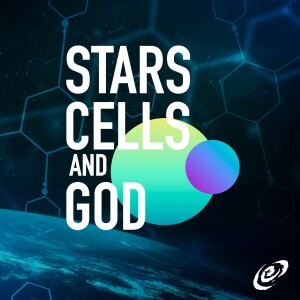Episodes

Wednesday Apr 02, 2025
Wednesday Apr 02, 2025
Join biochemist Fazale “Fuz” Rana and astrophysicist Jeff Zweerink as they discuss new discoveries with theological and philosophical implications pointing to the reality of God’s existence.
Can biotechnologists resurrect animals from extinction? Researchers from Colossal Bioscience have moved one step closer to making the woolly mammoth’s de-extinction a reality by gene-editing mice to exhibit woolly mammoth features. In this episode, biochemist Fuz Rana discusses this work and offers a Christian perspective on de-extinctions.
In the late 1960s, scientists theoretically worked out how to build a new class of materials that use the structure of the material (rather than the substance) to manipulate sound waves. It took another three decades to develop the technology to design and build them. Yet we find numerous examples of animals utilizing these novel-to-human materials. In this episode, we’ll discuss the science behind the durability of the mantis shrimp’s dactyl club (punching fist), which it uses to deliver blows without harming itself, and highlight the apologetic significance of these well-designed features found in nature.
LINKS & RESOURCES:
Rui Chen et al., “Multiplex-Edited Mice Recapitulate Woolly Mammoth Hair Phenotypes,” https://www.biorxiv.org/content/10.1101/2025.03.03.641227v1
Pablo D. Zavattieri, “Naturally Twisted to Sieve Stress,” https://www.science.org/doi/10.1126/science.adv3100
A. Alderete et al., “Does the Mantis Shrimp Pack a Phononic Shield?,” https://www.science.org/doi/10.1126/science.adq7100

Wednesday Mar 26, 2025
Wednesday Mar 26, 2025
Join biochemist Fazale “Fuz” Rana and astrophysicist Hugh Ross as they discuss discoveries with theological and philosophical implications pointing to the reality of God’s existence.
In this episode, biochemist Fuz Rana describes recent work from researchers at Rockefeller University. The researchers edited specific mouse genes to express the human version of the protein NOVA1, and they believe their research explains human language capability. Their findings add evidence for the exceptional nature of human beings and, consequently, the image of God.
Hugh discusses how four astrobiologists assert that intelligent life is the natural outcome of a hospitable environment. They note that the origin of life and every advance in Earth’s life occurred when physical and chemical conditions first permitted their appearance. Hence, they conclude that these appearances of life must be naturalistically straightforward and rapid. The team proposed a test of their hypothesis: exoplanets with the necessary physical and chemical conditions for each “hard step” in the origin and history of life will prove to be common and, in each case, chemical signatures for that life step will be found. Do the findings support their hypothesis?
Links & Resources:
A Humanized NOVA1 Splicing Factor Alters Mouse Vocal Communications
A Reassessment of the “Hard-Steps” Model for the Evolution of Intelligent Life
Who Was Adam? A Creation Model Approach to the Origin of Humanity

Wednesday Mar 19, 2025
Wednesday Mar 19, 2025
Join biochemist Fazale “Fuz” Rana and physician Steve Willing as they discuss discoveries with theological and philosophical implications pointing to the reality of God’s existence.
In this episode, Fuz and Steve critique a recent Nature Human Behaviour article published by researchers at The Trevor Project claiming that anti-transgender laws increase suicides in young people with gender dysphoria. Is this claim valid? What is the relationship between suicide and gender dysphoria, and how does this discussion relate to the gospel?
Links and Resources:
State-Level Anti-Transgender Laws Increase Past-Year Suicide Attempts Among Transgender and Non-Binary Young People in the USA
Gender Identity White Papers

Wednesday Mar 12, 2025
Wednesday Mar 12, 2025
Join astrophysicists Hugh Ross and Jeff Zweerink as they discuss discoveries with theological and philosophical implications pointing to the reality of God’s existence.
A team of biologists and geneticists collected over 500 samples from the leaves, roots, and bark of a single quaking aspen tree in Utah called Pando. This tree consists of 47,000 stems that cover 106 acres and it’s the world’s largest known organism. The team identified 4,000 genetic variations. They found that Pando’s triploid nature enhanced somatic mutations (noninherited DNA changes) gave Pando the just-right genetic diversity and resilience to thrive in a changing environment while maintaining genetic integrity. The team estimated that Pando is at least 16,000 years old and could be as old as 81,000 years old. The tree’s genetic designs enabled aspens and animals dependent on them to survive the radical climate changes that occurred during the last ice age. For almost three decades, astronomers have recognized that the amount of dark energy in our universe falls exceedingly short of the amount expected in our best models of the universe (for example, the big bang). One possible explanation for this enormous discrepancy is that human existence demands that we see the observed level because any larger amount would preclude human life. Although initial research showed promise for this explanation, a recent paper using more realistic models of star formation reveals some significant challenges.
Links and Resources:
Mosaic of Somatic Mutations in Earth’s Oldest Living Organism, Pando Many Physicists Argue the Universe Is Fine-Tuned for Life. Our Findings Question This Idea. The Impact of the Cosmological Constant on Past and Future Star Formation

Wednesday Mar 05, 2025
Wednesday Mar 05, 2025
Join biochemists Fazale “Fuz” Rana and Robert DiSilvestro as they discuss discoveries with theological and philosophical implications pointing to the reality of God’s existence.
Did life originate through evolutionary processes on the primordial Earth or through the handiwork of a Creator? In this episode Fuz and Robert critique one of the latest proposals from origin-of-life researchers for how proteins originated in the prebiotic world. In their analysis, Fuz and Robert show that a creation model best explains life’s origin.
Links and Resources:
Origins of Life: The Protein Folding Problem All Over Again?
Origins of Life: Biblical and Evolutionary Models Face Off by Fazale Rana and Hugh Ross

Wednesday Feb 26, 2025
Wednesday Feb 26, 2025
Join biochemist Fazale “Fuz” Rana and astrophysicist Hugh Ross as they discuss new discoveries with theological and philosophical implications pointing to the reality of God’s existence.
Young-earth creationists argue that the buildup of mutations quickly causes genomes to deteriorate, driving organisms to extinction. This process of genetic entropy occurs on a timescale of 6,000–10,000 years, indicating that Earth and life on Earth cannot be billions of years old. Drawing from recent work in genetics, biochemist Fuz Rana explains why this young-earth argument fails.
Little Red Dots (LRDs) are compact objects that are the emerging cores of large galaxies seen during the cosmic dawn (early stages of the universe). They were thought to challenge several big bang creation models because they were too bright. This challenge was based on the assumption that all their light came from stars. Spectra of LRDs show much of the light comes from gas spiraling into growing supermassive black holes at LRDs’ centers. This conclusion well fits big bang models where many first-to-form stars are hundreds of times the Sun’s mass.
Links and Resources:
Estimating the Proportion of Beneficial Mutations That Are Not Adaptive in Mammals
The Rise of Faint, Red AGN at z > 4: A Sample of Little Red Dots in the JWST Extragalactic Legacy Fields
Is the Big Bang Theory in Trouble?
A Matter of Days
Dinosaur Blood and the Age of the Earth

Wednesday Feb 19, 2025
Wednesday Feb 19, 2025
Join astrophysicists Hugh Ross and Jeff Zweerink as they discuss new discoveries with theological and philosophical implications pointing to the reality of God’s existence.
Dimethyl sulfide in a planet’s atmosphere has been widely cited as an unambiguous signature of life on the planet. However, the discovery of dimethyl sulfide in a comet, in the interstellar medium, and in laboratory photochemical experiments shows nonbiological pathways for the manufacture of dimethyl sulfide and other organosulfurs. Thus, the James Webb Space Telescope’s discovery of such organic compounds on exoplanets can’t prove life exists on another planet.
The seeds of big bang cosmology were planted nearly 100 years ago, and it stands as the reigning cosmology model for the last 60–70 years. What many people may not realize is that the mathematical foundation for the big bang rests on an approximation needed to solve Einstein’s equations of general relativity. Over the last 20 years, a growing group of scientists have argued that more accurate solutions that don’t utilize the approximation provide a better model of the universe while simultaneously removing the need for dark energy. We describe the basics of this new model and discuss the apologetics implications.
Links and Resources:
Carbon-Bearing Molecules in a Possible Hycean Atmosphere
Abiotic Production of Dimethyl Sulfide, Carbonyl Sulfide, and Other Organosulfur Gases Via Photochemistry: Implications for Biosignatures and Metabolic Potential
Evidence for Abiotic Dimethyl Sulfide in Cometary Matter
On the Abiotic Origin of Dimethyl Sulfide: Discovery of DMS in the Interstellar Medium
Dark Energy May Not Exist: Something Stranger Might Explain the Universe
Supernovae Evidence for Foundational Change to Cosmological Models

Wednesday Feb 12, 2025
Wednesday Feb 12, 2025
Join biochemist Fazale “Fuz” Rana and astrophysicist Jeff Zweerink as they discuss new discoveries with theological and philosophical implications pointing to the reality of God’s existence.
Fuz discusses the work of Chinese scientists who have identified the functional significance of the [genetic?] fusion event that seemingly generated human chromosome 2. This insight validates a key prediction of the RTB human origins model and adds credibility to the Bible’s description of humanity’s creation.
Jeff explains why scientists and engineers increasingly look to nature for inspiration to “build a better mousetrap.” Virtually every airplane in existence has a vertical tail that keeps the airplane on a straight line without rolling or spinning on its vertical axis. A recent study of how birds fly without a vertical tail reveals the sophisticated system of sensors, reflexes, and materials used to achieve “rudderless” flight. Far from a kludge job, such sophistication points to the work of a Creator who designed birds with this remarkable ability.
Links and Resources:
Incomplete Lineage Sorting of Segmental Duplications Defines the Human Chromosome 2 Fusion Site Early During African Great Ape Speciation
Bird-Inspired Reflexive Morphing Enables Rudderless Flight
Birdlike Robot Flies Steady Without a Vertical Tail
Thinking About Evolution, chapter 22, “Is the Watchmaker Really Blind?” by Fazale Rana

Wednesday Feb 05, 2025
Wednesday Feb 05, 2025
Join astrophysicists Hugh Ross and Jeff Zweerink as they discuss new discoveries with theological and philosophical implications pointing to the existence of God.
Hugh explains that the Dark Energy Spectroscopic Instrument (DESI) Collaboration has released redshift and position measurements on 3,855,000 galaxies and 857,000 quasars in the redshift range 0.1–2.1. Analysis of this database shows that gravity alternatives to general relativity on large cosmic size scales are negligible and provides stronger evidence for a time-varying dark energy equation of state. The analysis also yields the best measure to date of the cosmic matter density, thereby affirming a feature of cosmic creation. Jeff discusses how scientists over the past 10–15 years have discovered a tension between measurements of the Hubble constant from the early universe compared to the late universe. If found to be a real discrepancy, such a tension could point to new physics and a greater understanding of the development of the universe. A new study with data from James Webb Space Telescope (JWST) affirms the validity of the late Hubble constant measurement, strengthening the case for a legitimate discrepancy.
Links and Resources:
DESI 2024 VII: Cosmological Constraints from the Full-Shape Modeling of Clustering Measurements
Modified Gravity Constraints from the Full Shape Modeling of Clustering Measurements from DESI 2024
Hubble Constant Tension Resolution
Resolving Hubble Constant and Creation Tension
Universe Expansion Study Confirms Challenge to Cosmic Theory
JWST Validates HST Distance Measurements: Selection of Supernova Subsample Explains Differences in JWST Estimates of Local H0

Wednesday Jan 29, 2025
Wednesday Jan 29, 2025
Join biochemist Fazale “Fuz” Rana and OB/GYN Christina Cirucci as they discuss regret, desisting, and detransitioning among people who receive gender-affirming care.
How often do people change their minds after they transition to the opposite gender? What motivates that change of mind?
Can gender transitioning be fully reversed?
Warning: This content may include explicit material. Viewer discretion is advised. The intention is not to offend but to provide information. Proceed only if you are comfortable with conversations regarding gender-affirming care, gender reassignment surgeries, and detransitioning.
Disclaimer: Reasons to Believe is expressing our Christian beliefs on the issues of gender identity in the intersection of science and faith, as it’s an important discussion and many people have valid questions.
This research showcases the expertise of select members of the RTB Scholar Community on matters of gender identity. RTB is not offering medical or other professional advice. People need to consult with their own physicians, psychologists, psychiatrists, etc. We want to see everyone make informed, educated decisions.
Links and Resources:
Gender Identity White Papers: Learn to Defend Biblical Sexuality with Gentleness and Respect







